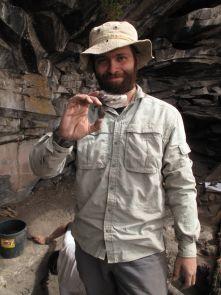University of Arizona
Source - http://uanews.org/story/high-life-in-the-andes-12-000-years-ago

New research shows that humans trekked up river canyons from the coastlands to make homes high up in the Andes. (Photo courtesy of Kurt Rademaker)
With the help of UA researchers, archaeologists have discovered that the highest known human occupation sites also are the world's oldest, challenging theories about the speed of human adaptation to high-altitude living.
Researchers at the University of Arizona have helped determine that human occupation sites in the southern Peruvian Andes not only are the highest known in the world, but also the oldest.
The UA scientists provided radiocarbon measurements that date the ice age settlements to the terminal Pleistocene about 12,000 years ago. An archaeological team led by researchers at the University of Maine has documented the sites, located nearly 15,000 feet above sea level, and published its findings in the journal Science. The discoveries date high-altitude human habitation nearly a millennium earlier than previously documented.
Despite cold temperatures, high solar radiation and low oxygen conditions at that altitude, hunter-gatherers colonized the remote, treeless landscapes within only 2,000 years after humans had arrived in South America, shattering theories postulating that humans required many generations to adapt to the challenges of high-altitude living.
"Studying human adaptation to extreme environments is important in understanding our cultural and genetic capacity for survival," according to the research team led by Kurt Rademaker, a University of Maine visiting assistant professor in anthropology.
"This is revolutionary," said Greg Hodgins of the UA's Accelerator Mass Spectrometer Lab in the UA'sDepartment of Physics. "The study provides evidence that people were living at those sites for a prolonged amount of time.
"When you look at the spectrum of animal bones left at the site, you get a pretty good idea that this wasn't just a temporary camp, where hunters butchered their game, cut off the best pieces and then carried them off to their home site in the lower elevations."

A member of the archaeology team holds a stone tool left behind by the first known high-altitude settlers. (Photo courtesy of Kurt Rademaker)
The Pucuncho archaeological site included 260 man-made tools, such as projectile points and scrapers up to 12,800 years old. Cuncaicha rockshelter, featuring two alcoves at 14,700 feet, contains a "robust, well-preserved and well-dated occupation sequence" up to 12,400 years old. The rockshelter, with views of wetland and grassland habitats, features sooted ceilings and rock art, and it probably was a base camp.
Most of the stone tools at Cuncaicha were made from locally available obsidian, andesite and jasper and are indicative of hunting and butchering consistent with limited subsistence options on the plateau, according to the researchers. In addition to plant remains, bones at the site indicate the hunting of vicuña, guanaco camelids and the taruca deer.
Pucuncho Basin was a high-altitude oasis for specialized hunting, particularly of vicuña, and later for herding of domesticated alpacas and llamas. The Pucuncho Basin could have sustained year-round residence. But wet-season storms and the dangers of hypothermia, as well as the need to maintain extended social networks and collection of edible plants, may have encouraged regular descents, according to the research team.
In addition, the stone tools and the debris left behind from their manufacturing included nonlocal, fine-grained rocks, some polished by water. That would have required the plateau residents to visit fast-flowing rivers in the lower elevations.
Hodgins' team dated animal bones found at the site using the carbon-14 method, also known as radiocarbon dating. Carbon-14 is a naturally occurring variant of carbon that is incorporated into living plant and animal tissues by natural biological processes. The technique takes advantage of the fact that carbon-14 decays at a predictable rate.
"When an organism dies, the level of carbon-14 in surviving tissues drops by one half every 5,730 years," Hodgins explained. "Measuring how much carbon-14 has been lost from a sample — for example, from a surviving piece of bone — allows us to calculate how much time has passed since the organism was alive."
It is unclear whether the high-altitude human settlement required genetic or environmental adaptations. But with evidence of high-altitude human habitation almost 900 years earlier than previously documented, the implication is that there may have been more moderate late-glacial Andean environments and greater physiological capabilities for Pleistocene humans.
"The Pucuncho Basin sites suggest that Pleistocene humans lived successfully at extreme high altitude, initiating organismal selection, developmental functional adaptations and lasting biogeographic expansion in the Andes," the researchers write. "As new studies identify potential genetic signatures of high-altitude adaptation in modern Andean populations, comparative genomic, physiologic and archaeological research will be needed to understand when and how these adaptations evolved."
The UA's Accelerator Mass Spectrometry Laboratory, headed by Tim Jull, has been a leader in radiocarbon research since 1981. Hodgins, who has been with the Laboratory since 2003, also holds appointments in the UA School of Anthropology and the Laboratory for Tree Ring Research.
In addition to Rademaker, who received his doctorate from the University of Maine and is now a postdoctoral researcher at the University of Tübingen in Germany, the research team members include: Katherine Moore, University of Pennsylvania; Sonia Zarrillo, University of Calgary; Christopher Miller, University of Tübingen; Peter Leach, University of Connecticut; David Reid, University of Illinois-Chicago; Willy Yépez Álvarez, Peru; and Gordon Bromley and Daniel Sandweiss, University of Maine.
The research was supported by the Dan and Betty Churchill Exploration Fund at the University of Maine, the National Geographic Society/Waitt Grants Program, and the National Science Foundation.